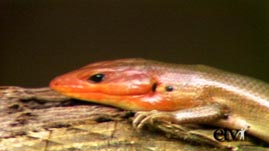Teachers' Domain - Digital Media for the Classroom and Professional Development
User: Preview

Source: NatureScene: “The Congaree Swamp”
In this video segment from NatureScene, host Jim Welch and naturalist Rudy Mancke come across a broadhead skink, an eastern mud turtle, and a brown water snake, each in its own habitat. They discuss characteristics and behaviors of these animals.
The diversity of organisms at the Congaree Swamp is one of its most notable features. The moist woods and grassy areas that predominate in the high ground of the floodplain forests are perfect environments for reptiles like the broadhead skink. And for the eastern mud turtles and brown water snakes that prefer the soft-bottomed, slow moving water of river bottom forests, the floodplain itself is ideal. Where there is abundant water and vegetation, these animals make themselves at home in the Congaree. The ability of reptiles to adapt easily to fluctuating water levels helps them flourish at Congaree. The swamp provides varying levels of sun and shade, as well as wet and dry areas, plus an abundance of prey, all of which helps these inhabitants control their metabolisms and reproduce.
Skinks are one of the largest of 20 families of lizards, hosting 600 species. The broadhead skink, especially the male, is one of a few most likely to be found high in trees. Broadhead skinks might also be found on or underneath logs or fallen trees, and are highly adaptable creatures that can also live in dry, sandy areas. Their diet consists of insects, spiders, and invertebrates, although they are also known to eat fruit, other lizards, and small mammals.
Broadhead skinks can grow as big as 12 inches. Like most skinks, the physical characteristics of the broadhead skink change throughout its lifetime according to its developmental stages. Juvenile skinks have blue tails. Like many lizards, the broadhead skink is able to break off its own tail when captured, thus distracting the predator in order to free itself. This capability, a defense mechanism called autonomy, works in tandem with the distracting blue tails of juveniles, a characteristic called deflective coloration.
Both juvenile and female broadhead skinks have five stripes, including two on either side of the body and one down the center of the back. These stripes fade as the skink matures, leaving it with a uniform grey or brown body. Adult males develop a prominent jaw and enlarged reddish-orange head that signals reproductive readiness.
Like skinks, most turtles are omnivores, feeding on vegetation, insects, mollusks, and carrion. The eastern mud turtle usually hides during the day and hunts underwater at night by scouring the bottoms of still waters like creeks, ditches, ponds or lakes. In the fall, adults find dry land to hibernate beneath, burying themselves in the ground and re-emerging in the spring for nesting. During spring and summer, females nest two or three times and bury their eggs. The eggs typically hatch in late summer. The hatchlings remain buried until the following spring. Predators of the eastern mud turtle include raccoons, river otters and water snakes, all inhabitants of the Congaree Swamp forest.
In addition to turtles, the non-venomous brown water snake also feeds mostly on frogs or fish. Some fish, however, prey on brown water snakes, as do alligators, raccoons, owls, and hawks. Ecologists have studied the brown water snakes by surgically implanting tracking devices to follow their ranges of movement. The scientists have found that some individuals will move or swim as far as four or five kilometers to locate food or mates. Brown water snakes prefer larger sized reservoirs, creeks, lakes, and rivers.
To learn more about the Congaree Swamp, check out Flood Plain and Higher Ground Habitats, Root Systems of Trees at the Congaree Swamp , Diversity of Hardwoods at Congaree Swamp, and Primitive Insects of the Congaree Swamp.
To learn about a different species of turtle, check out The Kemps Ridley Sea Turtle.
To learn more about snakes and some of their physical characteristics, check out Unhinged!.
To learn how different animals, such as reptiles, are classified according to certain physical characteristics and behaviors, check out Animal Classification Game.
 Loading Standards
Loading Standards